Pizza Dough Baker’s Percentage
This article will show you how this simple method can forever change your homemade pizza skills. It is a professional technique used by PROs.
We will also help you become a Pro; we’ll show you precisely what the baker’s percentage method is, how you can control it, and why this method is the best of any other method to make you a better pizza baker.
We are going to uncover the math behind making great pizza at home. At first, it will appear slightly intimidating but don’t worry.
Let us do the numbers; you only need your imagination!
Let’s get started!
Here’s What You Will Find:
Key Takeaways
Baker’s Percentage Method
Precision Matters: Weighing ingredients ensures consistent results and accurate proportions for your pizza dough. This attention to detail helps you achieve the perfect texture and flavor every time.
Scalability: This method allows for easy scaling of recipes. If you want to make half as much or twice as much, you simply adjust the quantities while keeping the percentages the same. This ensures consistency in the end product, no matter the batch size.
Flour is Always 100%: In the baker’s percentage method, the weight of the flour in the recipe is always denoted as 100%, and all other ingredients are calculated in relation to this. For example, if the water in a recipe is 60%, that means the water is 60% of the weight of the flour.
Understanding Hydration: Baker’s percentage is particularly useful for understanding hydration (the water content) in pizza dough. For instance, a pizza dough with a water percentage of 65% is considered a moderately hydrated dough, which will be somewhat sticky and will produce a crust with a nice, open crumb structure.
What is Baker’s Percentage?
Baker’s percentage or “Baker’s Math” expresses the ratios of ingredients to flour weight in a recipe. It’s used in professional baking and is especially helpful for scaling recipes up or down.
In a baker’s percentage, each ingredient in a recipe is expressed as a percentage of the flour’s weight, which is always considered to be 100%.
For example, if a pizza dough recipe calls for 1000 grams of flour and 600 grams of water, the water is 60% of the weight of the flour so it would be expressed as 60% in the baker’s percentage. The same applies to other ingredients like yeast, salt, and sugar.
This method allows for more consistency in baking, particularly in large-scale operations.
How to Calculate Baker’s Percentage?
Now for the fun part. The formula to calculate the baker’s percentage is as follows:
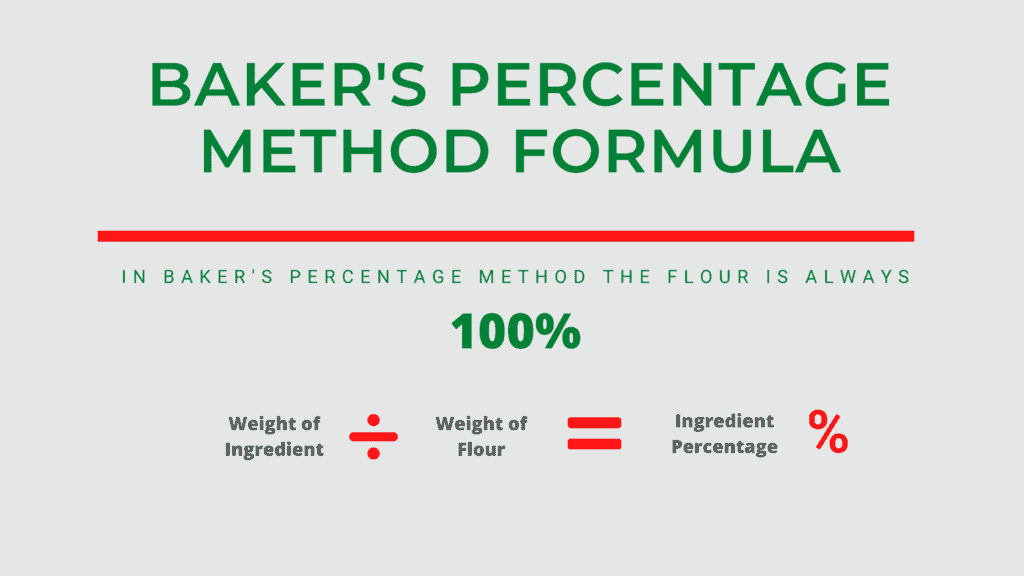
At first, you see the formula and think, “WTF!” (What the Flour!) But relax; it is not as complicated as it looks.
To calculate the baker’s percentage, you divide the weight of each ingredient by the flour’s weight, then multiply by 100 to get a percentage.
For example, if you have 500 grams of flour and 300 grams of water, the baker’s percentage of the water would be (300/500)*100 = 60%. So, the water is 60% of the flour’s weight. This method applies to all ingredients in the recipe, with the weight of the flour always considered to be 100%. This allows bakers to scale recipes up or down easily and to understand the relative proportions of the ingredients at a glance.
Let’s break it down; for example, our basic Neapolitan recipe calls for 500 grams of flour and 325 grams of grams (milliliters) of water; the formula would show the flour as 100% and the water as 65% (because 325 is 65% of 500). The recipe makes about two 10 to 12-inch pizzas.
The recipe also calls for 1% of yeast, then you calculate 1% of 500 (multiply 500 x .01) and get 5 grams plus 2% salt = 10g of salt. This way, you can scale to any amount of flour you want.
Let’s say you want to double the recipe and make four pizzas. You will need 1000 grams (500g x 2) of flour at 65% Hydration = 650 grams of water and 10g of yeast, and 20g of salt.
Easy!
Check Out this Ooni Video About Baker’s Math

Advantages of Using the Baker’s Percentage
Baker’s Percentage is an invaluable tool, often described as the backbone of professional baking. It operates on a simple principle – all ingredients are measured as a percentage of the flour’s weight, which is always 100%.
While it’s used across the whole baking spectrum, its utility shines bright in the world of pizza-making.
Let’s explore the various advantages of using the Baker’s Percentage for crafting the perfect pizza:
Consistency
Using baker’s percentages ensures that you maintain the same ratios of ingredients every time you bake, leading to a more predictable and consistent result.
Scalability
Whether you’re making pizza for a small family dinner or a large party, baker’s percentages make it easy to scale your recipe up or down while maintaining the balance of ingredients.
Hydration Control
By measuring water as a percentage of the flour weight, baker’s percentages give you precise control over your dough’s hydration level. This allows you to adjust the dough’s texture and crispness to your liking.
Adaptability
Baker’s percentages can accommodate adjustments for different types of flour, yeast, or other ingredients and even for environmental conditions like humidity or altitude.
Efficiency
Once you’re familiar with the system, baker’s percentages can simplify recipe reading and writing, making your baking process more efficient.
Learning Tool
Understanding and using baker’s percentages can deepen your understanding of baking science and help you become a more skilled and knowledgeable baker.
Cost Management
For professional bakers or pizzerias, using baker’s percentages can help in cost estimation and control, as it gives a clear understanding of the amount of each ingredient needed.
One of the advantages of using the baker’s percentage for pizza is that it allows you to easily convert your recipe into different weight measurements, such as pounds, ounces, kilograms, or grams.
Once all ingredients’ weights are calculated, it’s easy to scale, multiply, or divide the recipe.
By weighing your ingredients, your recipes will always be consistent because there is no room for error 10 grams are always 10 grams, and 1 cup of flour is never the same weight. Try it!
To make things even easier, you can just plug in the numbers in the chart below, giving you the numbers you need to make your recipe.
No need to do any calculations; just use your imagination and creativity to create the best pizza!
Check out our baker’s percentage calculator; let us do the math!
How to Weigh Ingredients for Pizza Dough
Before we start weighing any ingredients, keep in mind the following:
- You should be consistent with your unit of measurement. If you measure by ounces, pounds, or grams, all ingredients should be measured by ounces, pounds, or grams. Use only one unit of measurement; you need to be consistent.
- A good home-use scale will let you select between ounces, pounds, and grams. It’s better to work with grams when working with small amounts of ingredients; we will tell you why in a bit.
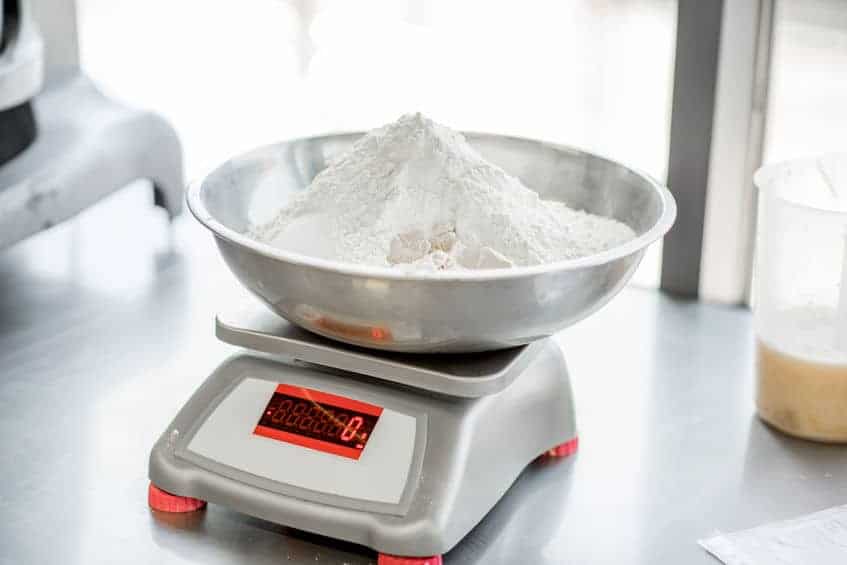
Always Weigh Your Ingredients in Grams
Pro Tip
In pizza dough recipes, adjusting the water content (usually 65% of the flour’s weight in Baker’s percentages) can affect the dough’s texture: a higher percentage leads to a more tender, open crumb, while a lower percentage yields a denser, firmer crust.
Weighing Ingredients
How to weigh ingredients using a scale:
If your dough recipe is given in volumetric measures, it doesn’t take too much to convert it to a baker’s percentage, but you will need to have a good scale available for weighing your ingredients.
- Get a separate container for each ingredient.
- Press the “Tare” button on the scale, bringing the level to 0.
- Start adding the ingredient to the container until the desired amount.
- Write down 100 percent after the flour weight (remember flour is always 100 percent). Then divide each ingredient’s weight by the flour’s weight and multiply by 100.
Do this for each ingredient that you are portioning.
Do this for each ingredient, and you have your formula in baker’s percentage. You can manipulate it up or down in size without changing other ingredients.
As you can see, baker’s percent will only work with weight measures; it will not work with volumetric measures (cups, teaspoons, tablespoons, etc.)
Why is it Better to Use Grams in Baker’s Percentage Method?
Using grams in the baker’s percentage method is preferred due to its precision and scalability. Grams, being a smaller unit than ounces or cups, allow for more accurate measurements, particularly crucial in baking where even slight variations in ingredient quantities can significantly impact the outcome.
In addition, the use of grams facilitates easy scaling of recipes. Whether you’re baking a small batch or producing in large quantities, converting the percentages to grams based on the total flour weight allows for consistent, proportional adjustments to all ingredients, ensuring the balance and quality of your dough remain consistent regardless of the batch size.
Grams are always a measure of weight, never volume, so there is no confusion. Ounces can be a measure of weight or volume, which can confuse some.
However, the main reason we use grams is that we handle small amounts of ingredients during the pizza-making process at home; with grams, these ingredients are easier to scale.
Grams are more straightforward to scale than any other unit of measurement. Why?
No fractions! All-round numbers, no need to round up or down.
Check this out. Wouldn’t it be easier to read and weigh 530 grams of flour on a scale than “1 pound, 2.695 ounces”? or isn’t adding 10 grams of yeast rather than .352 ounces easier?
Also, remember that most home baking scales can’t register decimals or fractions.
Pounds and ounces are a thing in the US. The rest of the world uses the metric system.
When you see a recipe with gram measures, don’t even think of doing the math to convert to ounces; flip the switch on your scale and start weighing.
Here’s the Scale the PROs at Homemade Pizza Pro Use and Recommend
The My Weigh KD8000 is a versatile Bakers Math Kitchen Scale with a large 8000g capacity and multiple weighing modes, including a percentage weighing function for precise baking. Its stainless steel platform is easy to clean, and the backlit weight display ensures easy reading. The hinged gunk shield adds convenience during messy applications—a must-have tool for accurate and consistent measurements in the kitchen.
Pizza Dough Baker’s Percentages
Pizza Dough Baker’s Percentages refer to the ratio of each ingredient in the dough relative to the weight of the flour, which is considered as 100%. This system, often known as the baker’s percentage, is vital for achieving consistency and balance in your pizza dough.
A standard homemade pizza dough recipe might be represented as 100% flour, 65% water, 2% salt, and 1% yeast. This means if you have 1000g of flour, you’ll use 650g of water, 20g of salt, and 10g of yeast.
These percentages allow you to understand the role of each ingredient: for instance, the water percentage (also known as hydration) influences the dough’s texture and crispness.
By using percentages, you can effortlessly scale the recipe to your needs, adjust ingredients based on environmental factors (like humidity or altitude), and ensure a consistent, high-quality result every time you prepare your pizza dough.
What is the Baker’s Percentage for Pizza Dough?
The best ratio for homemade pizza dough is 65%, meaning you will add 65% of water to the amount of flour. If you have 500g of flour, add 325g of water. This will give you the perfect pizza crust.
If you want to make any other style of pizza, you should try the following pizza dough baker’s percentages.
Pizza Dough Bakers Percentages
| Ingredient | Neapolitan | NY-Style | Sicilian | Chicago Deep |
|---|---|---|---|---|
| Flour | 100% | 100% | 100% | 100% |
| Water | 65% | 65% | 75% | 60% |
| Yeast | 1% | 1% | 1% | 1% |
| Salt | 2% | 2% | 2% | 2% |
| Oil | – | 5% | 2% | – |
| Sugar | – | 4% | – | – |
| Lard | – | – | – | 4% |
| Malt | – | – | 3% | 2% |
| Butter | 4% | |||
| Cornmeal | 5% |
For more on baker’s percentage per pizza style, check our baker’s percentage by pizza style charts.
Pizza Pun
I have a Tesla Stretch limo
It’s Elon-gated
For more on this, you can check our article A Baker’s Percentage Shortcut to Create Unique Pizza Recipes.
How to Calculate the Baker’s Percentage When You are Using Two or More Types of Flour
The baker’s percentage of 100% will only apply when using the basic flour needed for the dough mixture.
If a dough formula contains both white (bread flour) and whole-wheat flour, the total weight of the two flours will equal the total flour weight.
If a recipe calls for vital wheat gluten, the gluten weight will be added to the weight of the flour to arrive at the total flour weight.
If you are making Neo-Neapolitan or NY Style or Chicago Deep Dish that requires the addition of cornmeal, do not include it in the total flour weight.
The same goes for any other type of flour.
What is the Second Most Crucial Component of the Baker’s Percentage for Pizza?
Perhaps the second most crucial component of a baker’s percentage formula is the water’s weight relative to the flour’s weight or Hydration. The hydration level helps the baker predict the texture of the crumb. The more water in the dough, the more open the crumb. You can quickly identify this with large and irregular holes in the crust.
First, weigh the flour and water to calculate the hydration level of a recipe. Divide the water’s weight by the flour’s weight and then multiply the result by 100.
Let us show you an example of how it’s done; our base Neapolitan recipe contains 325g of water and 500g of flour, which results in 65 percent (325/500 = .65 x 100 = 65%) hydration level; this will result in a moderately airy crumb.
How Do You Find the Percentage of a Pizza Recipe?
To find the percentage of a pizza recipe using the baker’s percentage method, you first need to consider the total weight of the flour as 100%. Then, you calculate the weight of each other ingredient as a percentage of the flour’s weight.
Here’s a step-by-step guide:
- Weigh your flour – this is the base weight, which you consider as 100%.
- Weigh each of your other ingredients (water, yeast, salt, oil, sugar, etc.).
- For each ingredient, divide its weight by the weight of the flour and multiply the result by 100 to get the percentage.
For example, if you have 500g of flour and 300g of water, your water is 60% of your flour weight (because 300 ÷ 500 x 100 = 60). This means the baker’s percentage of the water in your recipe is 60%.
It’s important to remember that the baker’s percentage method is relative to the flour’s weight, not the total weight of all the ingredients combined. This method helps maintain consistency and allows you to scale your recipe up or down easily.
Related Questions:
How do I change a dough formula expressed in percentages to one based on weight measures?
If you have a recipe that is expressed in percentages instead of weights, you can calculate the weight of each ingredient by doing the following:
Going back to our base recipe expressed in percentages:
Flour 100%, Water 65%, 1% yeast, and 2% salt.
Now that we have the dough formula expressed in baker’s percent, we can manipulate the size of the dough based on the amount of flour we want to use.
Don’t forget we are making pizza, so the smallest pizza you can make would be maybe around 8 to 10 inches to be called pizza. Something smaller than that is called something else.
Thus, the minimum amount of flour you will need to make one pizza would be around 180g to 250g, depending on how thick you want your crust. Accordingly, you have 100% of the flour figured out.
Let’s say you use 200g of flour for one pizza; let’s do the numbers.
Your ingredients would look like this:
| Ingredient Percentage Calculation | Recommended Effect of Changing the Ratio |
|---|---|
| 200g Flour = 100% | You can make more or fewer pizzas |
| 130g Water = 65% (200 x .65 = 130) | Changes the texture and chewiness of the crumb |
| 2g Yeast = 1% (200 x .01 = 2) | More yeast accelerates the fermentation process, but less flavor |
| 4g Salt = 2% (200 x .02 = 4) | It affects fermentation, speed, and flavor |
There you have it, your pizza recipe for one person, based on what you chose according to the thickness, Hydration, Fermentation, and Saltiness. You can scale your formula to any recipe you like.
Note that the weight of the ingredient will always be shown in the same weight units (pounds, ounces, grams, kilograms, etc.) as the flour weight. In this case, we used grams.
How do professional bakers measure ingredients?
Always by weight!
Professional bakers primarily measure ingredients by weight using a digital scale, which ensures precision and consistency. This method is especially crucial in baking as slight changes in ingredient quantities can dramatically impact the result. They often use the metric system (grams, kilograms) because it’s more exact than the U.S. customary units (cups, tablespoons).
Professional bakers also use the Baker’s Percentage, a standard in the baking industry. This system expresses each ingredient’s weight as a percentage of the total flour weight (which is always 100%). It allows for easy recipe scaling and gives a clearer understanding of hydration levels and ingredient ratios.
Lastly, they pay attention to temperature – not just oven temperature but also the temperature of ingredients, like butter or water, which can affect the outcome of recipes. Professional bakers focus on precision, consistency, and understanding how each ingredient and process contributes to the final product.
Since pizzerias handle substantial amounts of dough, they typically measure in pounds, not grams. So the math will be more straightforward for them.
Here is the reason why.
1 pound of flour = approximately 454 grams, but you can only make about two pizzas with this amount of flour. You’ll need more flour when making over a hundred pizzas daily. So to make 100 pizzas, they will need 100 pounds, which is easier expressed in pounds than 45,400 grams.
Professional pizza makers or pizzaiolos use commercial equipment when making pizza at home; you can have a simple pocket scale.
What are the benefits of using baker’s percentage for pizza?
There are good reasons for using baker’s percent for our formulas. Baker’s percentage method allows you to:
- Easily compare recipes (i.e., which is saltier, breadier, yeastier, etc.).
- You will quickly identify a lousy recipe or predict its baked characteristics.
- You can add a single-ingredient percentage without changing the other ingredients’ proportions.
- You can uniformly measure a component where the quantity per unit may vary.
- You can scale recipes up or down; it’s a simple matter of multiplication or division for different dough batch sizes.2
- It allows easy conversion into pounds, ounces, kilograms, or grams.
- Since each ingredient is weighed, we can work with precision using only one unit of measure.
- And last, it allows bakers to share a common language.
The Last Slice
Once you stop thinking in units or volume and start thinking and measuring in grams, scaling recipes up and down will become quite simple.
Understanding the baker’s percentage for pizza will allow you to create your pizza recipes. You learned how different ratios of ingredients would interact to create numerous different types of pizza.
You have the recommended ratios for a great pizza; if you stay within these parameters, you should be fine. But if you want to break the rules and come up with something new, you can now troubleshoot your pizza recipe based on your ratios.
You are now ready to discover if something went wrong, like too much water or less salt. It’s all about the numbers, and you are now an expert!
The best thing is that now you can instantly use recipes and share your recipes with the whole world!
Baker’s Percentage Related Articles
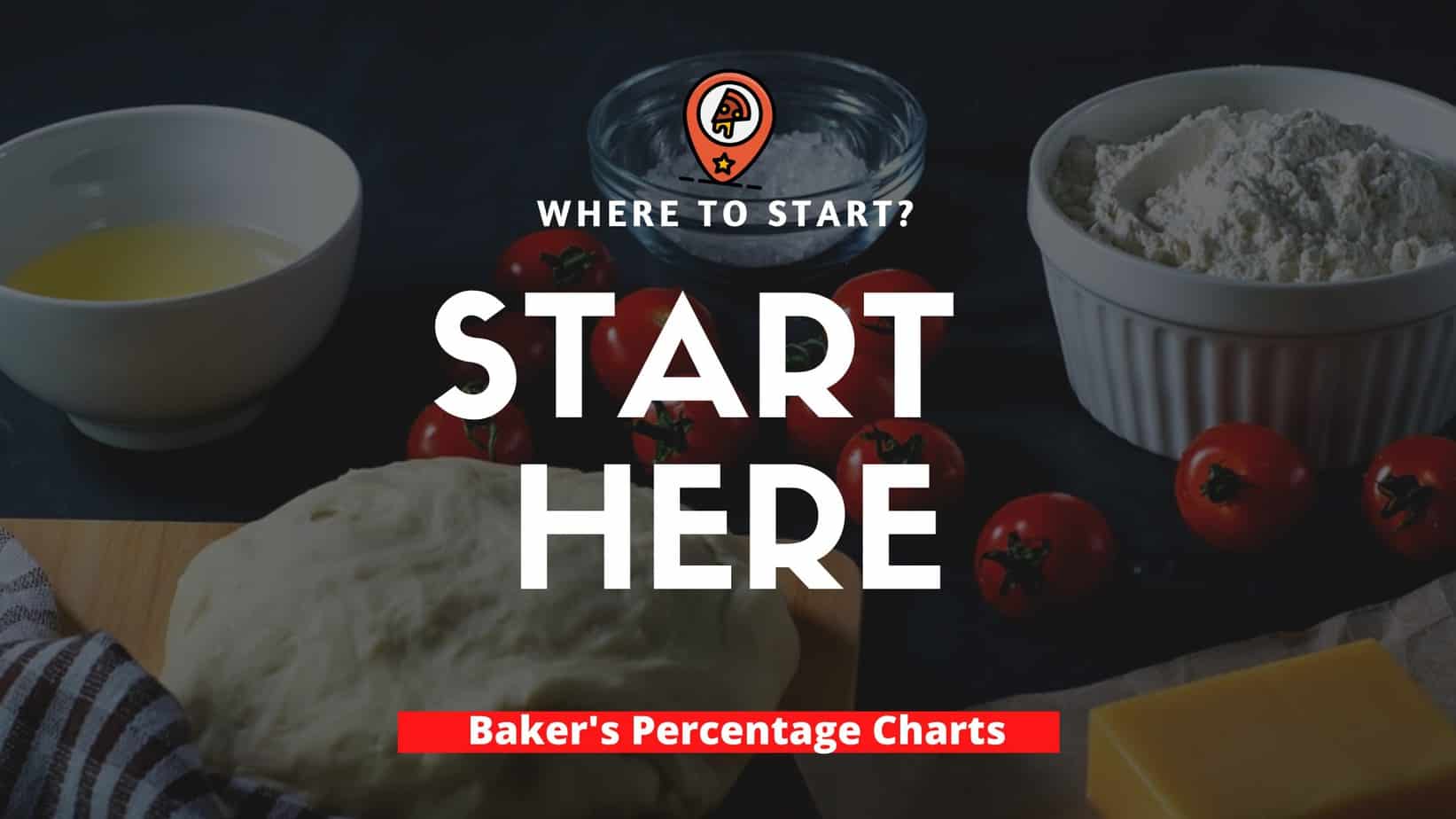
Baker’s Percentage Charts for Pizza Dough: Unlock the Secret Formula for Perfect Pizzas Every Time!
the PROs
This baker’s percentage chart will give you a starting point to develop your own recipe. These are the four main base recipes that can be adapted to any other pizza style.
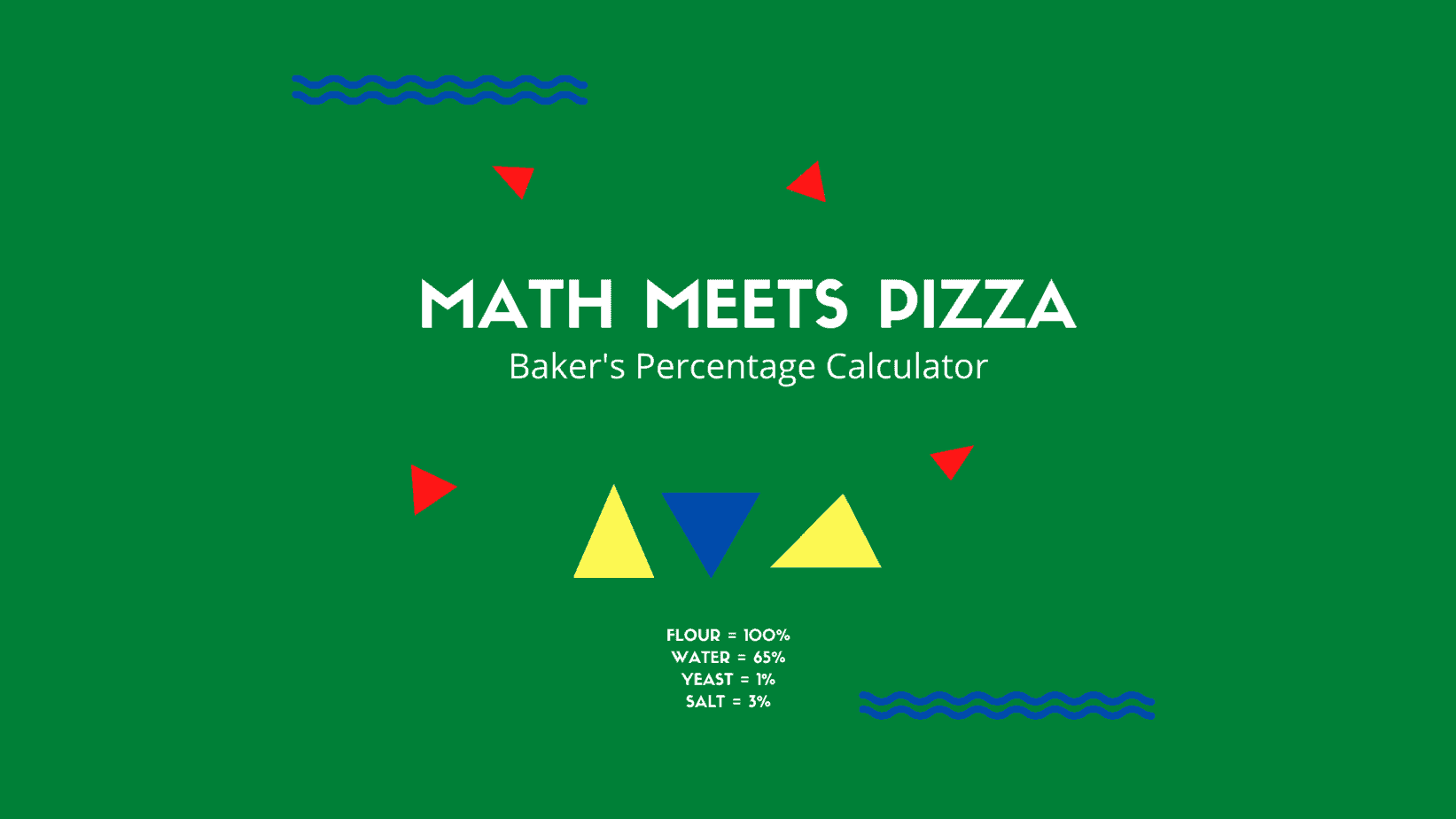
Bakers Percentage Calculator for Pizza Dough: Is as Easy as 123
the PROs
This Baker’s Percentage Calculator will allow you to you calculate the baker’s percentage for any given pizza recipe in a few seconds.

Master the Pizza Making Process Controlling these Powerful Pizza Elements
the PROs
Master the pizza craft with this guide, discover the elements of pizza and become a master pizza baker once you dominate these elements.
Check Amazon’s Pizza-Making Must-Haves
Why have two pizza peels when you can only have one. This pizza peel surpasses the benefits of wood peels with the convenience of a metal peel. It's made entirely from anodized aluminum for a lightweight design that's incredibly durable, too. It's designed to be used frequently in high-heat pizza ovens.
The Etekcity Lasergrip 800 Digital Infrared Thermometer is a versatile and reliable tool for accurate temperature measurements. Its non-contact design allows you to measure temperatures from a distance, making it safe and hygienic for various applications. With a wide temperature range of -58°F to 1382°F (-50°C to 750°C), this infrared thermometer is perfect for both everyday cooking needs and professional uses.
The built-in laser pointer helps you target the specific area you want to measure, ensuring precision and consistency. Whether you're grilling, cooking, or performing household maintenance, the Etekcity Lasergrip 800 provides fast and accurate temperature readings with ease.
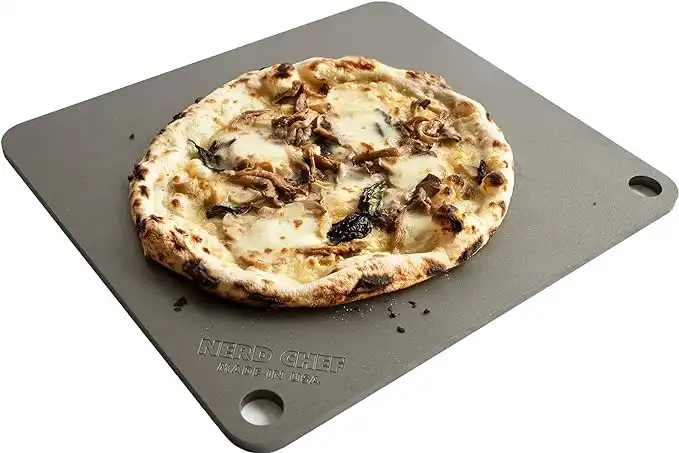 NerdChef Steel Stone
NerdChef Steel Stone
Making great crusts traditionally requires a 700-1000F wood-fired oven. Nerdchef Steel Stone replicates that performance in a home oven with its super-high heat transfer ability - transferring heat energy 20 times faster than ceramic. It creates beautiful and crispier crusts, gorgeous blistering throughout, and it cooks faster.
The Chef's flour is a general-purpose, high gluten flour that works well for many recipes. "Tipo 00" refers to how refined the flour is. Chef's Flour is best for those who want to bake in their traditional home oven up to 500 degrees Fahrenheit!
Enjoy!
Not a PRO? Not a Problem!
Take a pizza class to bring your pizza skills to the next level,
so you can be a PRO!
Related Posts

Costco Pizza Delivery: Find How You Can Get It Now!
the PROs
People go to Costco’s food court for many different reasons, but the cheesy slice of pizza they serve is among …

Pizza for Beginners: Don’t Buy Pizza, Make It! Here’s How to Get Started!
the PROs
You have this idea that you want to make pizza at home as opposed to ordering it, but where do you start? Don’t worry! Here you will find answers and directions to all your questions.

Pizza Toppings Under Cheese or Over Cheese? [Why the Order Matters]
the PROs
Is Pizza Cheese on Top or Bottom? Hey pizza lovers, are you wondering if you should layer pizza toppings under …
Newsletter
Subscribe to our Recipe of the Week newsletter and receive our partners’ latest recipes, tips, and discount offers.
Keep in Touch!
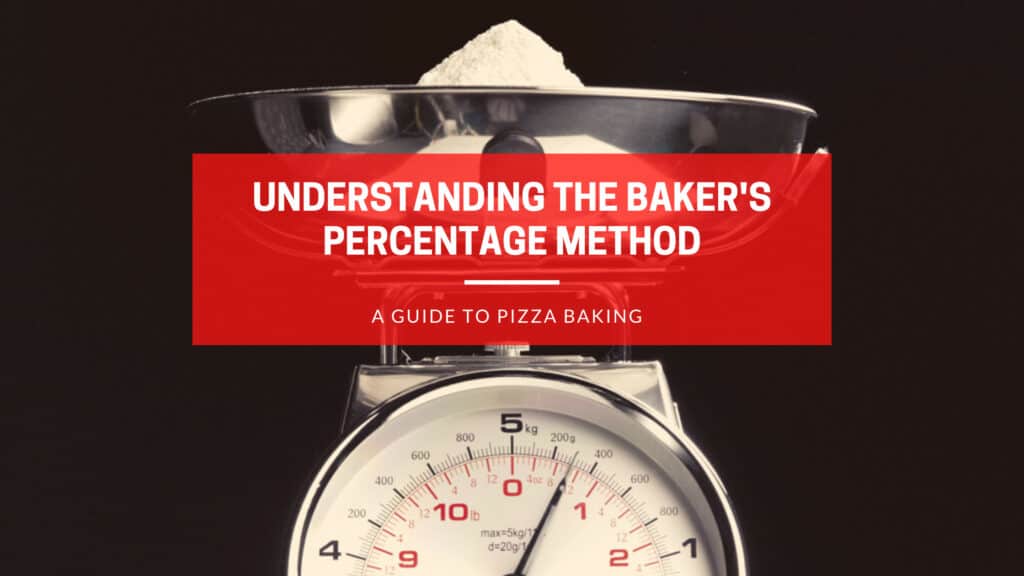
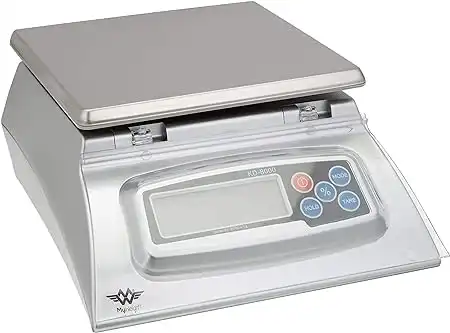


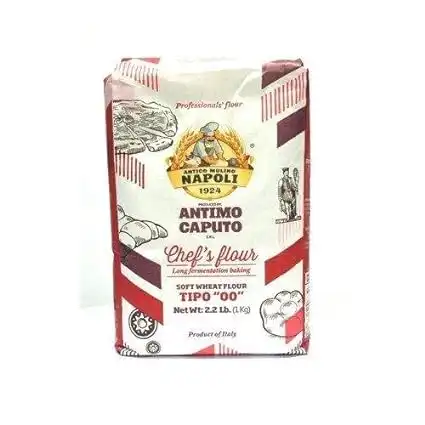

I’m extremely inspired with your writing abilities as smartly as with the structure on your blog. Is that this a paid subject or did you customize it your self? Anyway keep up the nice high quality writing, it’s rare to peer a great weblog like this one today.
Thanks for your inspiring comment. To answer your question, at HPP, we do everything ourselves, from the recipes to all web content and design. We strive to deliver the best content possible for our readers.